#24-14 All Conched Out, Part 2 - Adventures in Conchology
In which the E@L studies the secrets and surprises of whelk biology
My relationship with conchs goes back to my days as a graduate student in Charleston, SC, where I studied the reproductive biology of knobbed whelks for my Master of Science thesis. To find them, I would go out at night during low tides (since conchs are nocturnal predators), wading along the beaches and back creeks among the marshes surrounding Charleston. Using a flashlight or gas lantern, I scanned the shallow water for whelks feeding on clams, placing my catch in a bucket. I made sure to wear tough boots in case I stepped on a sting ray, which, rudely awakened, would explode out from under me in a frenzy, practically knocking me over. After filling my bucket, I would take my conchs back to the laboratory, where I dissected out their reproductive organs and analyzed them for their weight and nutrient content. As I related in Sex and the Single Snail, this work required me to identify male whelks by the presence of a penis.
Dredging for Knobbies
Years later, as a Professor of Marine Science, I studied channeled whelks in Massachusetts. My graduate student for this project, Bhae-Jin Peemoeller, had grown up in a family fishing conch for a living. In order to learn about the fishery, I once spent a long night aboard his family boat fishing for knobbed whelks, or “knobbies” as the watermen call them. We left the harbor in Norfolk, Virginia, at sunset and traveled a few miles offshore of Virginia Beach. There we began towing a large dredge back and forth in parallel rows. Each tow lasted about 30 minutes, after which I would help the deckhand sort the catch, tossing the whelks into garbage cans, and horseshoe crabs caught as bycatch into separate cans. This was fascinating work for the first few hours, but by midnight, I had collapsed into a heap in the galley, just long enough to catch a few Zzs before the next tow. Then the skipper (my afore-mentioned student) would kick me awake and I’d spend the next few minutes frantically sorting the catch while he turned the boat around and reset the dredge. In this situation, he was the teacher, and I the student.
Under his tutelage, I learned that knobbed whelks came out of the sand at night to feed, and by sunrise they would dig themselves back in so deep the dredge tines couldn’t reach them. Sure enough, as soon as the first golden glow appeared on the eastern horizon, our catches dropped off dramatically. By morning, we had filled two garbage cans full of conchs and four garbage cans full of horseshoe crabs, which were more valuable than the conchs. After returning to the harbor, we delivered all of our catch to a local wholesaler, who would cook the conchs whole before removing the meat and freezing it for shipment overseas. The horseshoe crabs were sold on to other markets farther north, where they would be used as bait for channeled whelks.
Potting for Conchs
In 2011 and 2012, we studied channeled whelks in Massachusetts with a local waterman, whom I will just call JD. He took us fishing with wooden or wire traps called pots. Unlike lobster traps, conch pots have wide slats (wood or rubber) along the sides allowing the conchs to ooze their way up and fall into an open top.
JD considered female horseshoe crabs to be the best bait because conchs were attracted to the eggs. Grasping a machete, he deftly chopped a horseshoe crab in half, exposing the ovary so that the odor would attract conchs. Then he strapped half of the crab into the bottom of the pot with a bungie cord and tossed the trap back into the water. By 2012, however, horseshoe crabs had become too scarce and expensive, and JD had started using crushed green crabs (an invasive species) and shark heads for bait, both of which he considered to be inferior baits.
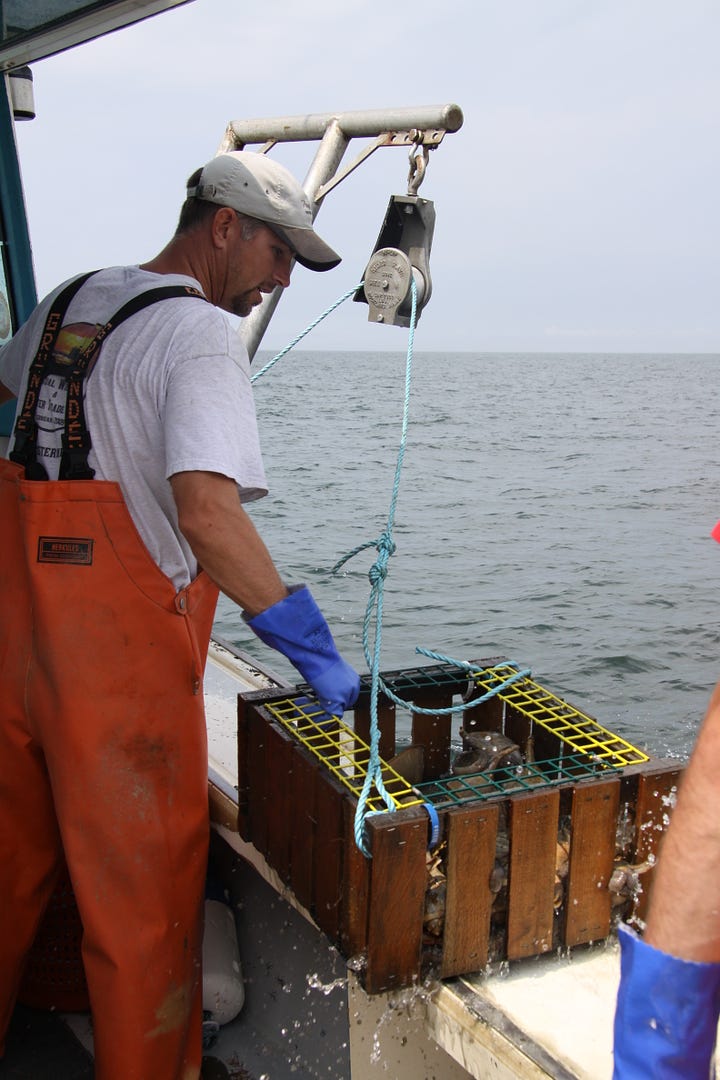

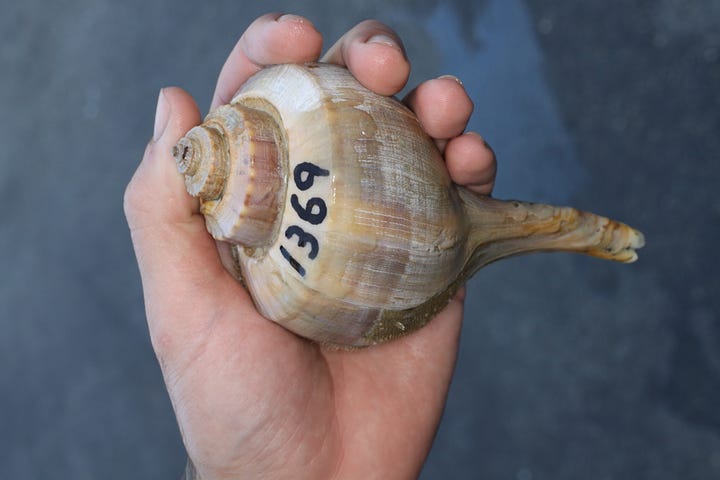
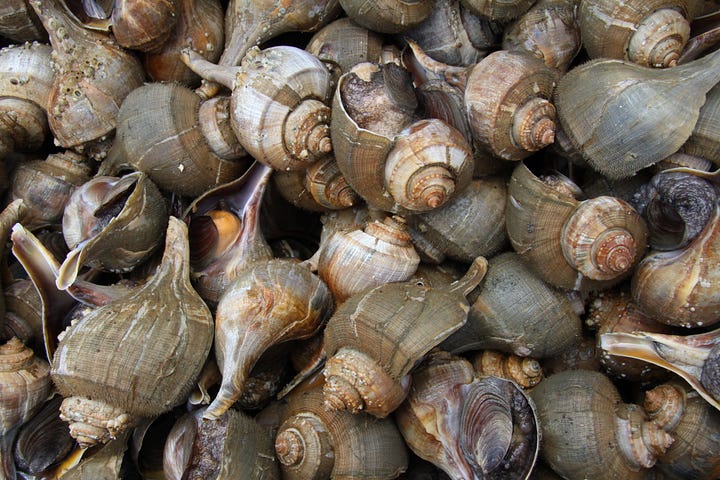
During our weekly chartered trips with JD, we pulled over 100 traps spread over a dozen locations in Buzzards Bay, MA. A day’s fishing typically produced 1500 conchs, which we brought back to the marine lab at the University of Massachusetts Dartmouth, where we held them in flowing seawater tanks. There, we spent a week measuring and weighing every conch, then marked it with an etched number and a glued tag, before releasing them back into the bay on our next fishing trip. We also dissected several hundred to assess their reproductive condition and counted the growth rings in their trapdoor-like operculum, in order to determine their age. A previous study done in Virginia suggested that male whelks changed sex after maturity, and we fully expected to corroborate that conclusion.
In the first year of this project, Bhae-Jin and I worked by ourselves. After long days of hauling, rebaiting, and setting 50-lb conch pots (much heavier when full of conch), we returned to the dock worn out, then often worked in the lab until late at night. The following year I was able to hire additional help; three undergraduate students traveled with us to Massachusetts, where I rented a house for them to stay. Even so, one of them became so seasick on our fishing trips that we told him to just wait for us at the dock. At the end of the season, I swore I would never lift another conch/crab/fish trap. In the future, that work would all be delegated to strong, young, energetic students.
Growth Opportunities
In each of the next two years, we revisited our release sites to recapture as many of our tagged whelks as possible, in order to measure their growth. Conchs don’t move very fast, and rarely travel more than a few miles from where they were born. Over two years, we marked and released almost 10,000 whelks, and recovered 300 of them, most very close to their release sites. To our surprise, we learned that male and female whelks grew at very different rates. Prior to maturity, growth rates were similar. But after maturity, males stopped growing, reaching maximum lengths of about 150 mm (6 in) and about 12 years of age. In contrast, females continued to grow up to 250 mm (10 in) in length and lived to at least 14 years, although JD has since recaptured some of our marked whelks over 8 years after release, suggesting they can live much longer than that. Despite our expectations, we never found any whelks that appeared to be transitional between male and female. We even measured penis length (yes, it’s a thing), learning that it grows continuously with male size, and we never found any shrinking. (Except for one individual, which we concluded was probably the victim of chemical pollution in New Bedford harbor).
But the most important thing we learned was that most whelks caught by the fishery had not yet reached sexual maturity or had a chance to reproduce. Furthermore, by removing the largest animals they were creating a fishery targeting primarily females. Soon after we published our study in 2013[i], the State of Massachusetts began increasing the minimum size limit for whelks, which they thought would fix the problem. The unfortunate side effect was that virtually all of the catch now consists of large mature females, which are being depleted at a faster rate. As we had suggested, this will probably lead to a reduction in female size and reproductive output, and a subsequent decline in conch populations. In a subsequent paper published in 2016[ii], we demonstrated that the largest conchs actually became shorter over time, due to both reduced growth and shell damage; we also suggested that maximum size limits be imposed on the whelk fishery to ensure that the largest females would be left to reproduce.
The “conventional” management philosophy for most fisheries is to protect the juveniles by creating minimum size limits (MSL). More recently, however, scientists have begun to realize that the “big old fat fecund females” (BOFFFs, as explained in Sustainable Seafood #3: What is Sustainability?) are the most important part of the population because they produce most of the reproductive effort. And the best way to protect them is to institute MAXimum size limits, i.e. require fishermen to throw back the largest females. But, to date, few fisheries have adopted this policy.
Queen of the Caribbean
In January of 2016 I traveled to the marine laboratory of the University of Puerto Rico, on an island near La Parguera, PR, with my Puerto Rican graduate student (now Dr.) Wilmelie Cruz-Marrero, where we met with Dr. Richard Appeldoorn. Together, we had submitted a grant proposal to NOAA and had been awarded $350,000 to study Caribbean Queen Conch (Lobatus gigas) in Puerto Rico. The project had grown out of Wilmelie’s MS thesis, for which we had built a digital underwater camera sled (Camsled) to assess seafloor ecosystems in the Maryland windpower development zone. Our plan was to use the Camsled to assess queen conch stocks in Puerto Rico, which were overfished. At La Parguera, we went scuba diving to inspect some potential study sites and inspected their 45-foot research vessel R/V Sultana to determine whether it could support our sled. Nine months later, in October of 2016, we shipped our Camsled and its components from Maryland then flew to Puerto Rico to begin our work.
As soon as we arrived, things began to go downhill. First, Hurricane Matthew roared up the US east coast, causing millions of dollars of damage in Florida and the Bahamas, and delaying our Camsled shipment by a week. When it finally arrived in the port of San Juan, customs officials (why does PR have its own customs?) held it up, claiming that we owed import duties on it. Phone calls to NOAA helped prove that it was federally funded scientific equipment and got it released. Wilmelie gave a cruise schedule to the captain of the research vessel, and a few days later we arrived at the dock to find…no boat. The captain had taken it out to work on another project without telling us. We rescheduled for a few days later, then arrived at the dock to find…no captain. He had taken the day off without telling us. Apparently, the captain did not like taking directions from a female grad student, even though she was a local who spoke fluent Spanish.
Eventually we resolved these issues and got out to do our work. First, teams of two divers dove to 50 feet depth and drove diver propulsion vehicles along the seafloor, stopping when we observed conchs to measure them and record shell condition (a proxy for age). After an hour, during which we covered about a kilometer, we surfaced and switched teams, continuing our survey. (Following one such dive, pain in my arm led me to think I might have decompression sickness, but a tele-medicine phone call indicated that wasn’t likely, and after a beer and two aspirin, my pain subsided).
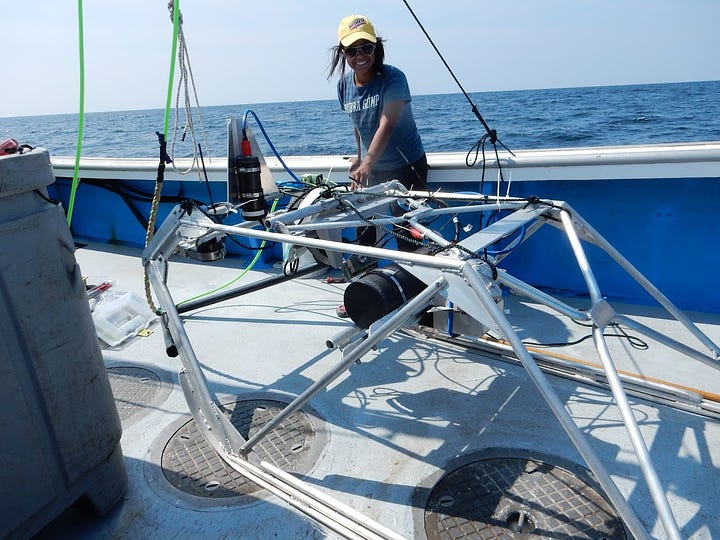
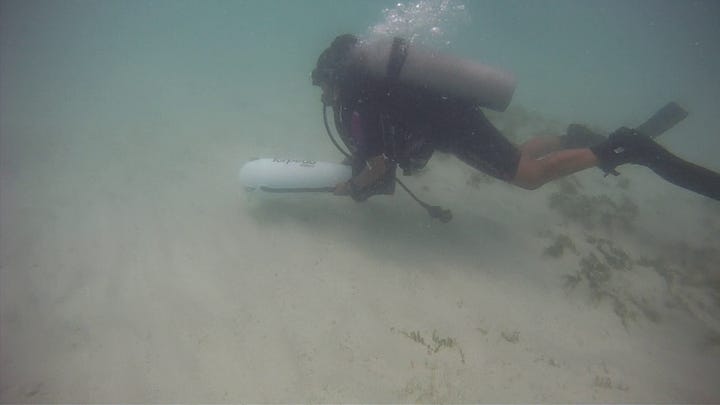
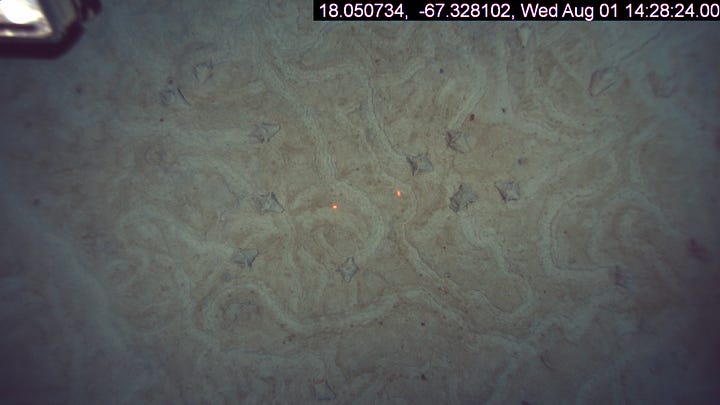

After completing eight such surveys over a period of two weeks, we began resurveying the same transect lines with the camera sled. Weather was always an issue, as the wind blew 15-20 knots every day. Launching the 300-pound sled from a boat while rocking in 4-5 foot seas was tricky and dangerous. We were lucky to get out on one or two days each week, and sometimes had to return to port without completing our work. What should have taken about two weeks ended up requiring almost two months of sea time.
Much later, back in Maryland, Wilmelie would spend many hours counting whelks in video images. Our results were surprising. Conch density estimates made by divers were 88 conch/hectare (about 35/acre), but estimates made by the Camsled were over twice as great (210 conch/ha). In addition, average size of whelks measured in Camsled images (using lasers) was smaller than measured by divers. We concluded that the Camsled was able to “see” small whelks that divers missed, and measurements made from images were more accurate than those made by divers [iii].
Another Blow
We had planned to return in 2017 to survey deeper sites with the sled, but Hurricane Maria hit Puerto Rico directly that year, causing massive damage to the electrical grid, so we didn’t return until 2018. That year, we conducted another eight Camsled surveys in deep water, out to depths of 50 m (>160 ft). Again, our results were surprising. Most biologists thought that queen conchs were limited to inshore habitats at depths <25 m, but we found high densities of conch at these “mesophotic” depths . We also photographed a group of juvenile conchs grazing the seafloor in a “wave” formation. This proved that deeper waters served as a refugia for both adult and juvenile conchs.
The queen conch fishery had primarily been conducted in shallow inshore waters, and was prohibited in Federal waters, beyond nine miles from shore, where our second round of surveys occurred. But we routinely encountered dive boats in that zone, and piles of dead conch shells left on the seafloor by divers, showing that the fishery had illegally expanded into the federal zone. Not only was this bad for the queen conch population, but it also led to an increase in the incidence of decompression sickness among the conch fishermen, few of whom were trained in deep water diving techniques.
All Conched Out
My professional interest in conchs has run its course. Nevertheless, in 2023 I was contacted by a lawyer working with Massachusetts conch fishermen, who were considering suing the State for mismanagement of the conch fishery. They claimed that whelk catches had declined dramatically, along with average size, essentially what we had predicted would happen ten years earlier. He had read both of our papers and wondered why the State had not implemented our suggestions. I could only tell him that another study by the Massachusetts Department of Marine Fisheries had confirmed our results. I explained to him about BOFFFs, and why they were important, but I did not want to get drawn into a legal argument with the state of Massachusetts. I knew and respected their scientists, even though I didn’t agree with their management policies. After all this time, I suppose I ought to feel vindicated about our conclusions. But I don’t. I’m just happy to know somebody read one of my obscure publications and found it useful. That’s the best result a scientist can hope for.
I still go beachcombing whenever I can. It’s always a thrill to find those elusive conch shells. I only keep the best ones. Then I put it to my ear and listen to the sea.
Writing about nature is not easy. It requires preparation, hard work, and sometimes sweat to observe nature, and time, thought, and effort to describe it. Although this post is free, becoming a paid subscriber will help me continue to share my thoughts, and encourage future postings.
Alternatively, if you would like to support my work with a one-off contribution, click “Buy me a coffee” below.
Sources
[i] Peemoeller, B-J., and B. G. Stevens. 2013. Age, Size, and Sexual Maturity of Channeled Whelk (Busycotypus canaliculatus) in Buzzards, Bay, MA. Fishery Bulletin, 111: 265-278. https://spo.nmfs.noaa.gov/sites/default/files/pdf-content/2013/peemoeller.pdf
[ii] Stevens, B. G., and B-J. Peemoeller. 2016. Sex differences in growth of channeled whelks from Buzzards Bay, Massachusetts, during one or two years at liberty. Marine and Coastal Fisheries 8: 462–475. DOI: 10.1080/19425120.2016.1194918
[iii] Cruz-Marrero, W., C. A. Harms-Tuohy, R. Appeldoorn, and B. G. Stevens. 2020. Comparison of video camera sled with diver surveys for queen conch Lobatus gigas (Linnaeus, 1758) density estimates in the west coast of Puerto Rico. Bulletin of Marine Science doi.org/10.5343/bms.2019.0087

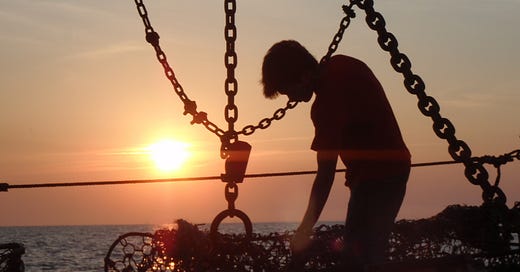



Back in 2011 or 2012, while snorkeling in Brown Bay, St John, USVI we saw numerous Queen Conch moving about in the sand through the sea grass beds. Sadly, we saw many shells lining the trail down to the beach and if memory serves correctly, this was within the boundaries of the National Park.
Very interesting thank you. Do Boffs apply to crabs and fish?